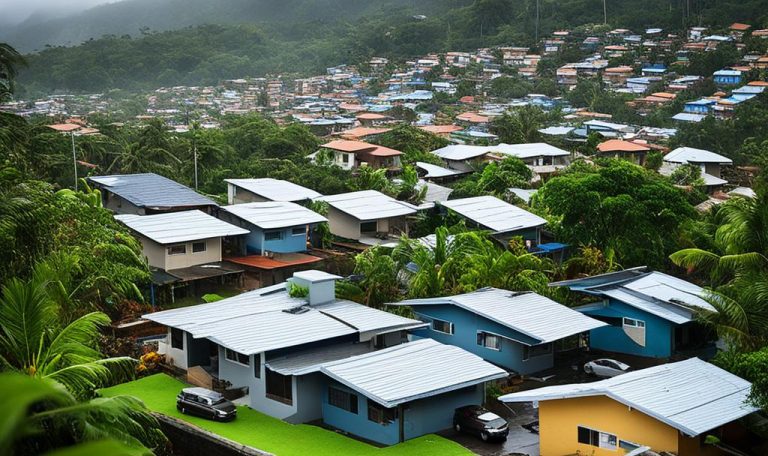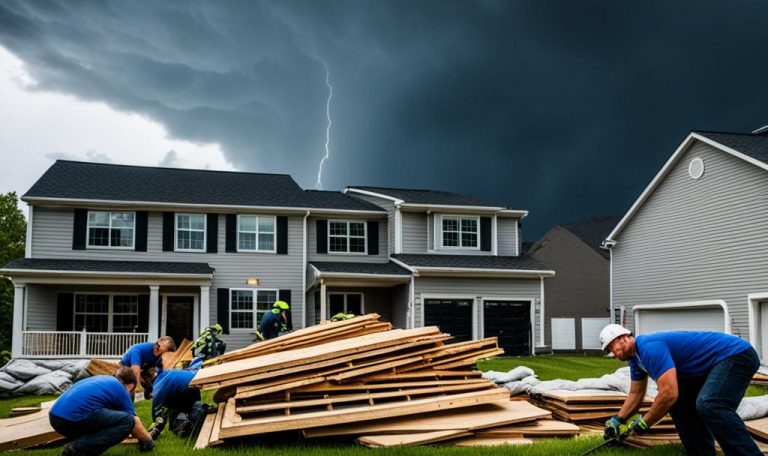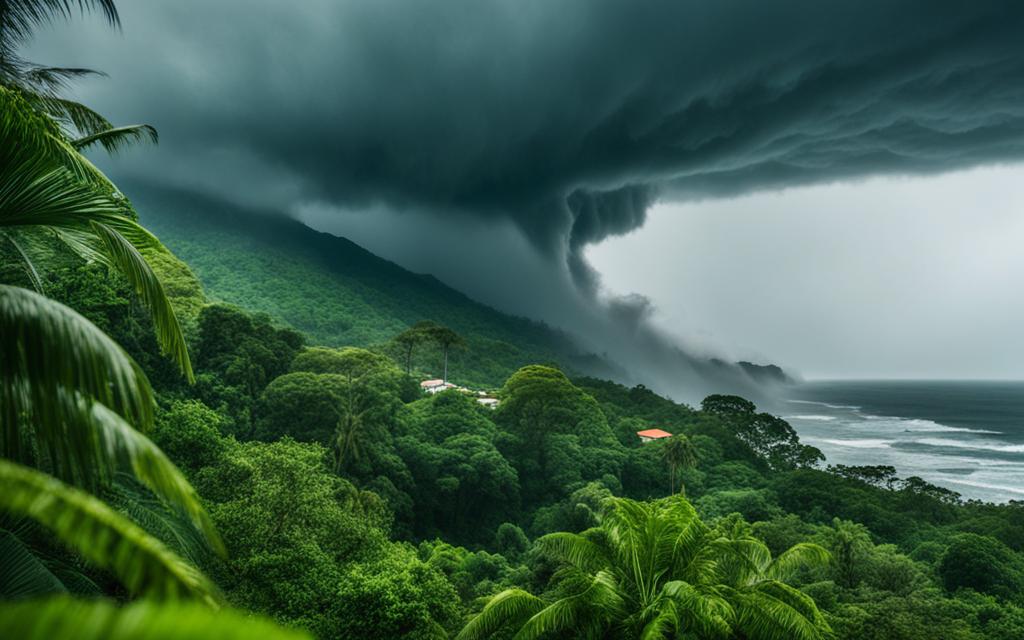The National Meteorological Institute (IMN) predicts that the 2024 cyclone season in Costa Rica will be more active than usual. With the presence of the La Niña phenomenon and warm Caribbean Sea temperatures, the country is bracing itself for potentially intense storms in the coming months.
Key Takeaways:
- Costa Rica is expecting an intense cyclone season in 2024.
- The La Niña phenomenon and warm Caribbean Sea temperatures contribute to the elevated activity.
- In 2023, Costa Rica experienced an increase in tropical cyclones compared to previous years.
- It is important for individuals to stay informed and prepared for potential storms.
- The National Emergency Commission is implementing measures to enhance preparedness and ensure the safety of the population.
Impact of El Niño and La Niña on Cyclone Season
The El Niño phenomenon has had a significant impact on weather patterns in Costa Rica, leading to drought conditions and high temperatures. However, the effects of El Niño are gradually weakening, and the country is expected to enter a neutral phase by May. But that’s not the end of the story. Another weather phenomenon, La Niña, is predicted to make an appearance during the second half of 2024. Both El Niño and La Niña play a crucial role in shaping the cyclone season in Costa Rica.
The abnormal behavior of Atlantic Ocean temperatures, coupled with the Pacific Ocean, has contributed to the unusual and active cyclone season seen recently. Typically, El Niño results in fewer weather events, but the recent phenomenon exhibited more intense activity than usual. This abnormal behavior has added complexity to the cyclone season, making it essential for Costa Rica to stay prepared and resilient.
One of the main implications of the El Niño and La Niña phenomena is their influence on ocean temperatures. These temperature anomalies can disrupt atmospheric circulation patterns, leading to changes in weather patterns around the world. In the case of Costa Rica, the abnormal behavior of Atlantic Ocean temperatures has created favorable conditions for the development and intensification of cyclones.
The impact of El Niño and La Niña on the cyclone season in Costa Rica is not limited to just the number of cyclones but also their intensity and track. The variations in sea surface temperatures can affect the formation and movement of cyclones, ultimately determining their impact on the country. As such, understanding the behavior of El Niño and La Niña is crucial for predicting and preparing for cyclone events.
Rainy Season Onset Across Costa Rica
The National Meteorological Institute has provided valuable information regarding the onset of the rainy season in different regions of Costa Rica. Knowing when the rainy season begins is crucial for the population and various sectors to prepare and mitigate the impacts of increased rainfall.
In the Central Pacific region, the onset of the rainy season is expected between April 22 and 28. Meanwhile, in the South, it is forecasted to begin between April 16 and 19. These dates provide an estimation for residents and businesses in these areas to make necessary arrangements.
The rest of the regions across Costa Rica, including the South Pacific, North Pacific, Central Valley, and Guatuso, Upala, and Los Chiles, will experience the rainy season at different times following the usual pattern. It is important for people in these regions to stay informed about the local weather forecasts to prepare accordingly.
However, it should be noted that the Caribbean coast continues to face a drought warning, indicating a lack of rainfall in this particular area. This has significant implications for the agricultural sector and other industries dependent on adequate water supply. Efforts to manage and minimize the impacts of drought conditions are being undertaken to support the affected regions.
Anticipating the Rainy Season
As the rainy season approaches, community members, farmers, and other stakeholders should take proactive measures to ensure their readiness. Some recommended actions include:
- Clearing and maintaining drainage systems to prevent flooding
- Securing loose objects to minimize damage from strong winds
- Stocking up on essential supplies such as food, water, and medications
- Updating emergency kits with necessary supplies
By taking these steps, individuals and communities can enhance their preparedness and resilience in the face of the rainy season.
Quote:
The rainy season in Costa Rica is a time of transformation and rejuvenation. It brings nourishment to the land, but it also requires us to be prepared and adaptable. By keeping a close eye on the weather forecasts and taking necessary precautions, we can embrace the rainy season while minimizing its potential challenges.
Measures Taken by the National Emergency Commission (CNE)
To ensure the safety of the population during the upcoming rainy season and anticipated intense cyclones, the National Emergency Commission (CNE) in Costa Rica has implemented a series of measures and coordinated actions. These proactive steps are aimed at enhancing preparedness and minimizing the potential risks associated with the cyclone season.
The CNE collaborates closely with other institutions, including government agencies, local authorities, and community organizations, to address the challenges posed by the rainy season and ensure effective disaster management. By working together, they aim to mitigate the impact of cyclones and protect the well-being of Costa Rican citizens.
Some of the key measures undertaken by the National Emergency Commission include:
- Developing and implementing early warning systems to provide timely information and alerts to the population, enabling them to take necessary precautions in advance.
- Coordinating emergency response efforts among various agencies to ensure a swift and effective response to cyclone-related incidents.
- Establishing communication networks to facilitate efficient dissemination of critical information, instructions, and updates to the affected communities.
- Conducting training programs and workshops to enhance the capacity of emergency responders and community members in disaster preparedness, response, and recovery.
- Identifying and designating evacuation routes and safe shelters to provide refuge for individuals and families in areas at high risk of cyclones.
- Implementing measures to protect infrastructure and critical facilities, such as reinforcing buildings, improving drainage systems, and securing essential utilities.
The National Emergency Commission recognizes the importance of proactive planning and preparedness in minimizing the impact of cyclones and protecting lives and property. By taking these measures and fostering collaboration among stakeholders, the CNE aims to ensure the safety and resilience of Costa Rica in the face of challenging weather conditions.
Safety Tips for Costa Rica Cyclone Season
During the cyclone season in Costa Rica, it is crucial for individuals to prioritize their safety and take necessary precautions. By being prepared and informed, you can effectively mitigate the risks associated with intense cyclones. Here are some safety tips to help you navigate this season:
1. Stay Informed
Stay updated about weather conditions and cyclone forecasts by relying on reliable sources such as the National Meteorological Institute. Regularly check for updates and advisories to stay ahead of any potential storms.
2. Create a Family Emergency Plan
Develop a comprehensive emergency plan with your family. This plan should include designated meeting points, contact information for emergency services, and strategies for communication and evacuation. Make sure every family member understands and is aware of the plan.
3. Secure Loose Objects
Prioritize securing any loose objects around your property. Strong winds associated with cyclones can easily turn these objects into hazards, causing damage to your property or posing a risk to individuals. Secure or store outdoor furniture, garden tools, and any other loose items.
4. Stock Up on Essential Supplies
Prepare an emergency supply kit that includes essential items such as food, water, prescription medications, flashlight, batteries, first aid kit, and important documents. Make sure your kit is easily accessible and regularly check its contents to ensure everything is up to date.
5. Familiarize Yourself with Evacuation Routes and Shelters
Know the evacuation routes in your area and familiarize yourself with the locations of nearby shelters. Be aware of the designated safe areas in your community and have a plan for reaching them quickly in the event of an evacuation order.
“By being prepared and informed, you can effectively mitigate the risks associated with intense cyclones.”
Following these safety tips will ensure that you and your loved ones are prepared and ready to face the cyclone season in Costa Rica. Remember, taking proactive measures and staying informed are key to protecting yourself and your community during these challenging weather events.
| Safety Tips |
|---|
| Stay informed about weather updates |
| Create a family emergency plan |
| Secure loose objects |
| Stock up on essential supplies |
| Familiarize yourself with evacuation routes and shelters |

Importance of Early Warning Systems
When it comes to cyclones, early warning systems are a crucial component of ensuring safety and minimizing the impact on Costa Rica. These systems provide valuable information by forecasting and monitoring the development of cyclones, allowing individuals and communities to take necessary actions before the cyclone strikes.
Investing in robust early warning systems is of utmost importance for the government and local authorities. By doing so, they can ensure that accurate and timely alerts are disseminated to the general public, helping them prepare and respond effectively during cyclone events.
Early warning systems help in:
- Identifying the presence and intensity of cyclones
- Monitoring the movement and trajectory of cyclones
- Alerting individuals and communities in advance
- Providing safety instructions and evacuation guidelines
- Assisting in coordinating rescue and relief efforts
By accessing these vital pieces of information through early warning systems, Costa Ricans can take necessary precautions, secure their property, and evacuate to safer locations if required.
“Early warning systems are our first line of defense when it comes to cyclones. They give us the crucial time needed to prepare, evacuate, and ensure the safety of our communities.”
As we strive for a safer Costa Rica, it is essential to prioritize the development and improvement of early warning systems. By making them accessible and user-friendly, we empower individuals and communities with the knowledge and tools needed to protect themselves and their loved ones.
Community Preparedness Efforts
Community preparedness plays a critical role in reducing the vulnerability associated with cyclone impacts during the cyclone season in Costa Rica. Local communities can actively participate in various preparedness initiatives to enhance their resilience and ability to respond effectively during cyclone events.
Conducting Drills
Organizing drills and simulations is an effective way to prepare community members for cyclone-related emergencies. These drills can help individuals practice evacuation procedures, familiarize themselves with emergency shelters, and develop a better understanding of the necessary safety precautions.
Organizing Awareness Campaigns
Creating awareness about cyclone preparedness and safety measures is crucial for community members in Costa Rica. Organizing awareness campaigns through local schools, community centers, and media platforms can disseminate valuable information on evacuation routes, emergency contacts, and the importance of early warning systems.
Establishing Communication Networks
Establishing communication networks within communities is essential for effective coordination and response during cyclone events. These networks can enable residents to share information, report emergencies, and provide mutual support. Encouraging the use of communication apps, neighborhood groups, or community forums can foster collaboration and strengthen community resilience.
“By working together and fostering community preparedness efforts, we can build resilience in the face of cyclones and protect the well-being of our neighbors.”

Community preparedness is about empowering individuals, fostering a sense of collective responsibility, and ensuring that everyone has the knowledge and resources to face cyclone season with confidence. It is these proactive efforts that can make a significant difference in minimizing the impact of cyclones and safeguarding the lives and well-being of Costa Rican communities.
| Benefits of Community Preparedness | Actions for Effective Preparedness |
|---|---|
| 1. Enhanced resilience | 1. Conduct regular drills and simulations |
| 2. Improved coordination and response | 2. Organize awareness campaigns |
| 3. Prompt sharing of information | 3. Establish communication networks |
| 4. Mutual support and community bonding | 4. Encourage community engagement |
Infrastructure Resilience Measures
When it comes to facing the challenges of cyclones in Costa Rica, enhancing infrastructure resilience is of utmost importance. By implementing specific measures, Costa Rica can minimize the damage caused by these powerful storms and ensure a safer environment for its citizens.
One crucial aspect of infrastructure resilience is the construction of storm-resistant buildings. These structures are designed to withstand the strong winds and heavy rain associated with cyclones, offering protection and minimizing the risk of structural damages and collapses.
Improving drainage systems is another key measure that can enhance infrastructure resilience. By implementing effective drainage mechanisms, Costa Rica can prevent or reduce the impacts of flooding during cyclonic events. Proper drainage not only helps in the evacuation of excess water but also prevents the accumulation of water in critical areas.
Reinforcing critical infrastructure is also crucial to withstand the force of cyclones. This includes reinforcing bridges, power grids, communication networks, and other vital systems essential for the functioning of the country. By ensuring the resilience of critical infrastructure, Costa Rica can minimize disruptions and facilitate a quicker recovery process after cyclonic events.
By investing in resilient infrastructure and implementing these measures, Costa Rica can reduce the impact of cyclones and enhance the safety and well-being of its residents. It is essential for the government and relevant authorities to prioritize infrastructure resilience and allocate resources accordingly.
International Collaboration in Disaster Management
During cyclone events, international collaboration plays a pivotal role in effective disaster management. Costa Rica has the opportunity to benefit from the expertise, resources, and best practices shared by countries with extensive experience in cyclone preparedness and response. Collaborative efforts can include the exchange of knowledge, implementation of training programs, and participation in joint exercises to enhance disaster management capabilities.
By fostering international collaboration, Costa Rica can tap into a wealth of wisdom and experience from other nations that have successfully dealt with cyclones. This exchange of information can help Costa Rica develop robust strategies and practices that are tailored to its unique cyclone challenges.
Benefits of International Collaboration
By engaging in international collaboration in the field of disaster management, Costa Rica can enjoy several significant benefits:
- Access to best practices: Collaborating with countries that have effective disaster management systems allows Costa Rica to learn from established practices and implement them in their own strategies.
- Shared knowledge and expertise: Learning from the experiences and expertise of other nations equips Costa Rica with invaluable insights and innovative approaches to ensure better preparedness and response.
- Pooling of resources: International collaboration promotes the pooling of resources and technical capabilities, enabling Costa Rica to access specialized equipment, manpower, and financial aid during cyclone events.
- Enhanced coordination and communication: Collaborating with other countries fosters better coordination and communication channels, facilitating the exchange of critical information and streamlining disaster management efforts.
- Increased resilience: By leveraging international collaboration, Costa Rica can enhance its overall resilience to cyclones, mitigating potential risks and minimizing the impact on its communities and infrastructure.
Examples of International Collaborations
Costa Rica has already taken steps to engage in international collaborations for disaster management:
“We are excited to announce our collaborative agreement with the United States Federal Emergency Management Agency (FEMA). This partnership will allow us to exchange knowledge and expertise in cyclone preparedness and response, ultimately enhancing our capabilities and ensuring the safety of our citizens.” – Costa Rican National Emergency Commission spokesperson
Furthermore, Costa Rica has established partnerships with countries such as Japan and Australia to share insights and practices in disaster management. Through these collaborations, Costa Rica aims to build a resilient cyclone preparedness framework that takes into account global best practices.
Conclusion
As Costa Rica gears up for the intense cyclone season of 2024, it is crucial for individuals and communities to prioritize readiness and safety. With the National Meteorological Institute’s forecasts pointing to elevated activity, it is evident that the presence of the La Niña phenomenon and warm Caribbean Sea temperatures are significant contributing factors to this heightened cyclone season.
To effectively manage these challenges, it is essential for everyone in Costa Rica to stay informed about weather updates, follow the guidance provided by the National Emergency Commission, and take necessary safety precautions. Creating a family emergency plan, securing loose objects, stocking up on essential supplies, and familiarizing oneself with evacuation routes and shelters are just a few of the measures that can help mitigate the risks associated with intense cyclones.
Additionally, collaboration and unity are key in facing these natural disasters. By being prepared and working together as a community, Costa Rica can enhance its resilience and ability to respond effectively during cyclone events. Infrastructure resilience, early warning systems, and international collaboration in disaster management also play crucial roles in minimizing the impact of cyclones and facilitating a quicker recovery process.
With a proactive approach towards preparation and a collective effort towards safety, Costa Rica can navigate through the upcoming cyclone season with determination and resilience. By staying alert, taking action, and relying on the guidance and support of relevant authorities, the people of Costa Rica can ensure their well-being and minimize the potential damage caused by these intense storms.



